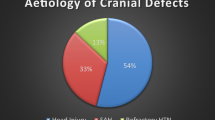Abstract
Purpose
Frontal bone deformities can be acquired due to trauma or ablative tumor resection surgeries and osteomyelitis. It may also occur due to congenital malformations. Repair of these defects have long been a challenge to oral and maxillofacial surgeons. We report our experience in the reconstruction of acquired frontal bone defects by titanium mesh implant.
Patients and Methods
Titanium mesh was used for reconstruction in 35 patients (18–55 years age-group) (34 males and 01 females) of acquired frontal bone defects secondary to trauma (RTA). All these patients have been referred to author by Department of Neurosurgery of the institute of Affiliation.
Results
All these cases acquired defects as a result of trauma. Follow-up ranged from 12 to 18 months after the reconstruction. Patients were followed up for the progress of healing, stability of implants, infection, wound dehiscence, discharging sinus, exposure of implants, collections, patient satisfaction regarding esthetics and reaction to thermal changes. No postoperative complications were found.
Conclusion
In reconstruction of frontal bone defects, titanium mesh gives satisfactory results.


Similar content being viewed by others
References
Haug RH, Adams JM, Conforti PJ, Likavek MJ (1994) Cranial fractures associated with facial fractures. J Oral Maxillofac Surg 52:729–733
Zanotti B, Zingaretti N, Verlicchi A, Robiony M, Alfieri A, Parodi PC (2016) Cranioplasty: review of materials. J Craniofac Surg 27(8):2061–2072
Williams LR, Fan KF, Bentley RP (2015) Custom-made titanium cranioplasty: early and late complications of 151 cranioplasties and review of the literature. Int J Oral Maxillofac Surg 44(5):599–608
Lin AY, Kinsella CR Jr, Rottgers SA, Smith DM, Grunwaldt LJ, Cooper GM, Losee JE (2012) Custom porous polyethylene implants for large-scale pediatric skull reconstruction: early outcomes. J Craniofac Surg 23(1):67–70
Manson PN (1990) Facial injuries. In: McCarthy JG (ed) Plastic surgery. WB Saunders, Philadelphia, pp 867–1141
McCarthy J, Zide BM (1984) The spectrum of calvarial bone grafting: introduction of the vascularized calvarial bone flap. Plast Reconstr Surg 74:10
Hunter PD, Pelofsky S (1995) Classification of autogenous skull grafts in cranial reconstruction. J Craniomaxillofac Trauma 14:8–15
Cohen SR, Kawamoto HK (1992) Analysis and results of treatment of established pest traumatic facial deformities. Plast Reconstr Surg 90(4):574–584
Van Gool AY (1985) Preformed polymethyl methacrylate cranioplasties. J Oral Maxillofac Surg 13:2–8
Brown KE (1970) Fabrication of an alloplastic cranioimplant. J Prosthet Dent 24:213–224
Sabin H, Karvounis P (1969) The neurosurgeon-dentist team in cranioplasty. JADA 79:1183–1188
Replogle RE, Lanzino G, Francel P (1996) Acrylic cranioplasty using miniplate struts. Neurosurgery 39:747–749
Galicich JH, Hovind KH (1967) Stainless steel mesh-acrylic cranioplasty technical note. J Neurosurg 27:376–378
Engstrand T, Kihlström L, Lundgren K, Trobos M, Engqvist H, Thomsen P (2015) Bioceramic implant induces bone healing of cranial defects. Plast Reconstr Surg Glob Open 3(8):e491
Malis LI (1989) Titanium mesh and acrylic cranioplasty. Neurosurgery 25:351–355
Patel MF, Langdon ID (1991) Titanium mesh osteosynthesis: a fast and adaptable method of semirigid fixation. Br J Oral Maxillofac Surg 29:316–324
Simpson D (1954) Titanium in cranioplasty. Br Med J 11(2):19–225
Mukherjee S, Thakur B, Haq I, Hettige S, Martin AJ (2014) Complications of titanium cranioplasty—a retrospective analysis of 174 patients. Acta Neurochir (Wien) 156(5):989–998
Hill CS, Luoma AM, Wilson SR, Kitchen N (2012) Titanium cranioplasty and the prediction of complications. Br J Neurosurg 26(6):832–837. https://doi.org/10.3109/02688697.2012.692839
Acknowledgements
Prof. (Col) P Suresh Menon, Department of Neurosurgery and Anesthesia. Dr S.N. Medical College Jodhpur.
Author information
Authors and Affiliations
Corresponding author
Ethics declarations
Conflict of interest
The author declares that they have no conflict of interest.
Informed consent
Informed consent was obtained from all individual participants included in the study.
Rights and permissions
About this article
Cite this article
Chattopadhyay, C. Reconstruction of Acquired Frontal Bone Defects Using Titanium Mesh Implants: A Retrospective Study. J. Maxillofac. Oral Surg. 18, 34–39 (2019). https://doi.org/10.1007/s12663-018-1083-6
Received:
Accepted:
Published:
Issue Date:
DOI: https://doi.org/10.1007/s12663-018-1083-6




